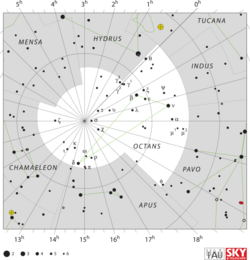Upsilon Octantis
Topic: Astronomy
 From HandWiki - Reading time: 3 min
From HandWiki - Reading time: 3 min
| Observation data Epoch J2000.0 Equinox (celestial coordinates) | |
|---|---|
| Constellation | Octans |
| Right ascension | 22h 31m 37.5152s[1] |
| Declination | −85° 58′ 02.1104″[1] |
| Apparent magnitude (V) | 5.75±0.01[2] |
| Characteristics | |
| Spectral type | K0 III[3] |
| U−B color index | +0.88[4] |
| B−V color index | +1.02[4] |
| Astrometry | |
| Radial velocity (Rv) | 19±7.8[5] km/s |
| Proper motion (μ) | RA: −37.556[1] mas/yr Dec.: +61.431[1] mas/yr |
| Parallax (π) | 9.5042 ± 0.0351[1] mas |
| Distance | 343 ± 1 ly (105.2 ± 0.4 pc) |
| Absolute magnitude (MV) | +0.77[6] |
| Details[7] | |
| Mass | 2.12±0.07 M☉ |
| Radius | 10.3±0.2 R☉ |
| Luminosity | 56±1.1 L☉ |
| Surface gravity (log g) | 2.7±0.1 cgs |
| Temperature | 4,910±42 K |
| Metallicity [Fe/H] | 0.00±0.03 dex |
| Rotational velocity (v sin i) | 1.5±1.3[8] km/s |
| Other designations | |
| Database references | |
| SIMBAD | data |
Upsilon Octantis (Upsilon Oct), Latinized from υ Octantis, is a solitary star[10] in the southern circumpolar constellation Octans. It is faintly visible to the naked eye with an apparent magnitude of 5.75[2] and is located 343 light years away from the Solar System.[1] However, it is receding with a heliocentric radial velocity of 19 km/s.[5]
Upsilon Oct has a stellar classification of K0 III,[3] indicating that it is a red giant. At present it has 2.12 times the mass of the Sun but has expanded to 10.3 times its girth.[7] It shines with a luminosity of 56 solar luminosity from its enlarged photosphere at an effective temperature of 4,910 K,[7] giving a yellowish orange hue when viewed at night. Upsilon Oct has a solar metallicity, with an iron abundance equivalent to the Sun's.[7] It spins leisurely with a poorly-constrained projected rotational velocity of 1.5 km/s.[8]
References
- ↑ 1.0 1.1 1.2 1.3 1.4 Brown, A. G. A. (2021). "Gaia Early Data Release 3: Summary of the contents and survey properties". Astronomy & Astrophysics 649: A1. doi:10.1051/0004-6361/202039657. Bibcode: 2021A&A...649A...1G. Gaia EDR3 record for this source at VizieR.
- ↑ 2.0 2.1 Høg, E.; Fabricius, C.; Makarov, V. V.; Urban, S.; Corbin, T.; Wycoff, G.; Bastian, U.; Schwekendiek, P. et al. (March 2000). "The Tycho-2 catalogue of the 2.5 million brightest stars". Astronomy and Astrophysics 355: L27–L30. ISSN 0004-6361. Bibcode: 2000A&A...355L..27H.
- ↑ 3.0 3.1 Houk, N.; Cowley, A. P. (1975). University of Michigan Catalogue of two-dimensional spectral types for the HD stars. Volume I. Declinations -90_ to -53_ƒ0.. Bibcode: 1975mcts.book.....H.
- ↑ 4.0 4.1 Johnson, H. L.; Mitchell, R. I.; Iriarte, B.; Wisniewski, W. Z. (1966). "UBVRIJKL Photometry of the Bright Stars". Communications of the Lunar and Planetary Laboratory 4: 99–110. Bibcode: 1966CoLPL...4...99J.
- ↑ 5.0 5.1 Kharchenko, N.V.; Scholz, R.-D.; Piskunov, A.E.; Röser, S.; Schilbach, E. (November 2007). "Astrophysical supplements to the ASCC-2.5: Ia. Radial velocities of ~55000 stars and mean radial velocities of 516 Galactic open clusters and associations". Astronomische Nachrichten 328 (9): 889–896. doi:10.1002/asna.200710776. ISSN 0004-6337. Bibcode: 2007AN....328..889K.
- ↑ Anderson, E.; Francis, Ch. (May 2012). "XHIP: An extended hipparcos compilation" (in en). Astronomy Letters 38 (5): 331–346. doi:10.1134/S1063773712050015. ISSN 1063-7737. Bibcode: 2012AstL...38..331A.
- ↑ 7.0 7.1 7.2 7.3 Ottoni, G.; Udry, S.; Ségransan, D.; Buldgen, G.; Lovis, C.; Eggenberger, P.; Pezzotti, C.; Adibekyan, V. et al. (January 2022). "CORALIE radial-velocity search for companions around evolved stars (CASCADES): I. Sample definition and first results: Three new planets orbiting giant stars". Astronomy & Astrophysics 657: A87. doi:10.1051/0004-6361/202040078. ISSN 0004-6361. Bibcode: 2022A&A...657A..87O.
- ↑ 8.0 8.1 De Medeiros, J. R.; Alves, S.; Udry, S.; Andersen, J.; Nordström, B.; Mayor, M. (January 2014). "A catalog of rotational and radial velocities for evolved stars: V. Southern stars⋆⋆⋆". Astronomy & Astrophysics 561: A126. doi:10.1051/0004-6361/201220762. ISSN 0004-6361. Bibcode: 2014A&A...561A.126D.
- ↑ "ups Oct". SIMBAD. Centre de données astronomiques de Strasbourg. http://simbad.u-strasbg.fr/simbad/sim-basic?Ident=ups+Oct.
- ↑ Eggleton, P. P.; Tokovinin, A. A. (11 September 2008). "A catalogue of multiplicity among bright stellar systems". Monthly Notices of the Royal Astronomical Society 389 (2): 869–879. doi:10.1111/j.1365-2966.2008.13596.x. ISSN 0035-8711. Bibcode: 2008MNRAS.389..869E.
<ref> tag with name "Gould1879" defined in <references> is not used in prior text.
 |
 KSF
KSF
